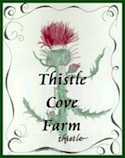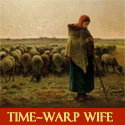
Years ago, in the Dayton, Ohio area, we had a weather man, Gil Whitney, who not only relied upon technology to help predict the weather, but he was also a firm believer in the actions of nature to aid his predictions. One of his favorites was the wooly worm. {As a side note: Gil's timely warning to the residents of Xenia, Ohio to "take shelter immediately," saved many lives on April 3rd, 1974, as an F5 tornado tore that area apart. I can still remember running into the house to turn the T.V. on as the rumbling clouds passed over our house on their way to Xenia. You can watch part of his historic broadcast by clicking here & scrolling to the bottom of the page.}
As someone who not only grew up w/parents who grew up on farms & who watched the actions of nature to help w/their farm & garden planning, I also married a farm boy. :-) I think one of the reasons I enjoyed Gil's use of nature in his weather forecasts was b/c I heard the same stories from my grandparents & my daddy. The Old Farmer's Almanac was never far from my grandpa's favorite chair & it's reliability is still uncanny. This year, the Almanac is predicting a very cold winter for our area...not more snow than normal...just more COLD! Brrrrrrrr! And judging by the nearly all black woolies I've seen lately as they try to cross the roads around here, I'm afraid the Almanac just might be right...again. :-/

Here's a little woolie info for you to be watching out for...
Using wooly worms (Pyrrharctia isabella) to predict winter is old American folklore that traces its history back to early Americana. Supposedly, Native Americans taught the pioneers to read wooly worms to predict winter weather. Wooly worm is the common name for the larval stage of the Isabella Tiger Moth. They are also called wooly bears.
Step 1
Look for wooly worms under rocks and inside hollow logs.
Step 2
Examine the wooly worm, paying attention to its bands of colors. The wooly worm will curl into a ball when touched or threatened. When they crawl, they can crawl very quickly!
Step 3
Wooly worm forecasters say that the size of the brown band of color will tell you what kind of winter is coming. Legend says that the thinner the brownish red bands, the harsher the winter will be. If the wooly worm is mostly brownish red in the middle, winter will be mild.
Step 4
Wooly worm enthusiasts claim an 85 percent success rate over the last few decades. Scientists tend to disagree and say wooly worm weather prediction is as unscientific as using groundhogs to predict winter weather. The groundhogs likely side with the wooly worms.
Step 5
Whether or not you believe in the power of wooly worms, they can be a fun project for children and adults.
{from www.ehow.com}
Blessings from Ohio...Kim<><




















 Edinburgh
Edinburgh









































































No comments:
Post a Comment